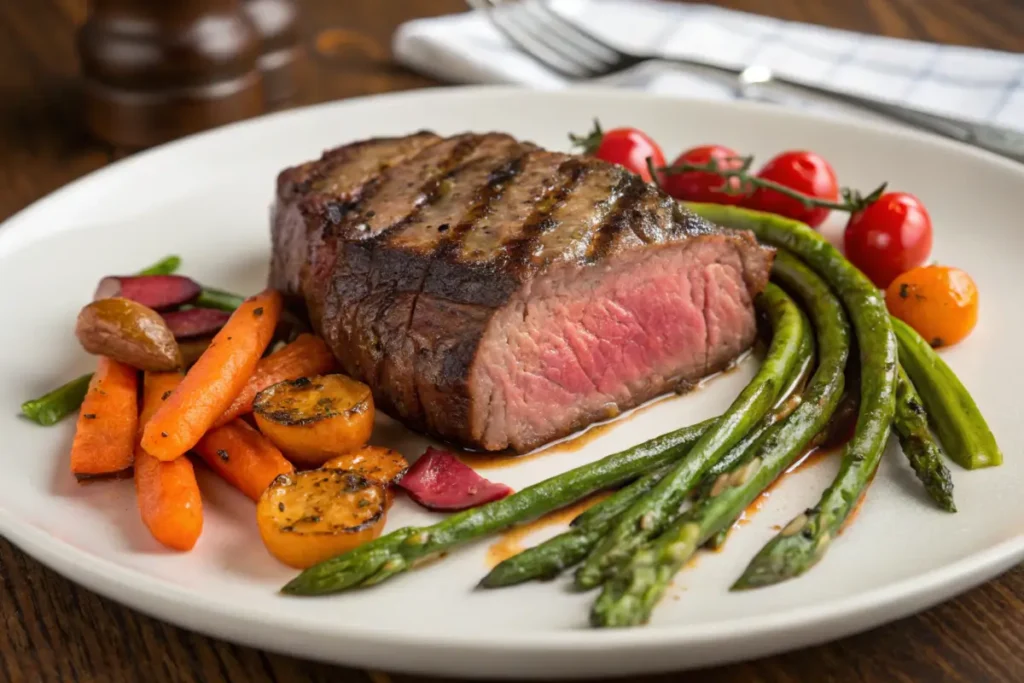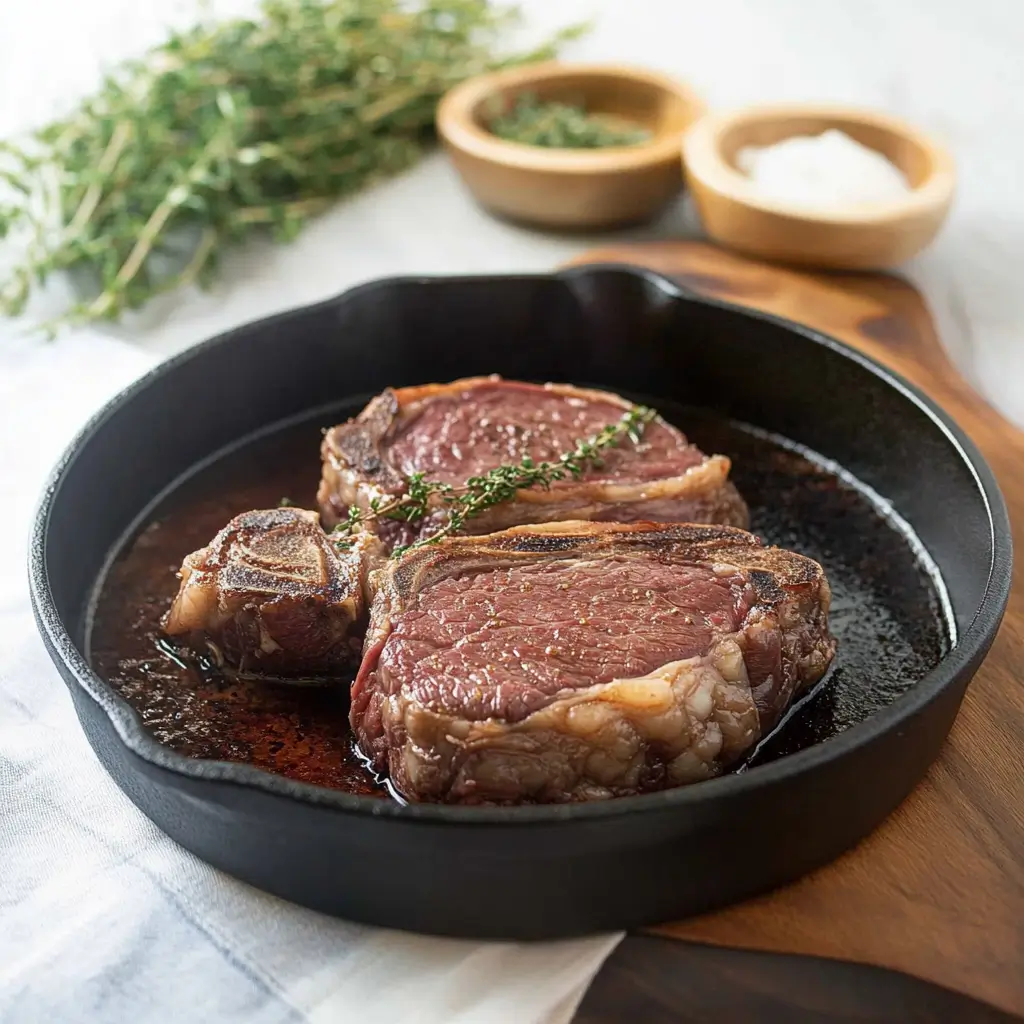Table of Contents
Ah, the chuck eye steak—a hidden gem in the culinary world, often overshadowed by its pricier cousins like the ribeye. But don’t let its affordability fool you. This versatile cut packs robust flavors, tender texture, and incredible value for your money. In this guide, we’ll dive deep into what makes this steak so special, its nutritional perks, expert cooking methods, and mouthwatering recipes. Whether you’re a seasoned chef or a home cook looking to explore, this guide has you covered.
What is Chuck Eye Steak?
Origins and Cut of Meat
The chuck eye steak comes from the upper shoulder region of the cow, specifically the chuck primal. This cut sits right next to the ribeye, borrowing much of its rich marbling and beefy flavor. Because it shares these traits with ribeye, chuck eye steak has earned the nickname “poor man’s ribeye.” It’s like finding a diamond in the rough for steak lovers.
Chuck eye steak is typically sold as 2-3 inch thick portions with a good balance of meat and fat. The chuck primal itself is a hardworking area, but this specific part stands out due to its tenderness compared to other shoulder cuts.
Comparing Chuck Eye Steak and Ribeye
While ribeye is prized for its rich marbling and melt-in-your-mouth texture, chuck eye steak delivers a similar flavor profile at a much lower cost. Both cuts offer excellent marbling, though ribeye is slightly more tender. However, when it comes to affordable, everyday meals, chuck eye steak is a standout choice that works beautifully for both grilling and pan-searing.
💡 Many people also confuse chuck eye with Delmonico steak. If you’re curious about the differences, check out Is Chuck Eye Steak the Same as Delmonico? for a detailed comparison of their textures, flavors, and best cooking methods.
Why It’s Called the “Poor Man’s Ribeye”
Affordability is a key factor behind the nickname. Ribeye steaks often come with premium price tags, while chuck eye steaks deliver comparable flavors without breaking the bank. For budget-conscious foodies, this cut is a game-changer. It’s a hidden treasure for those who crave gourmet flavors on a weekday budget.
Nutritional Benefits of Chuck Eye Steak
Macro and Micronutrients
When it comes to fueling your body, chuck eye steak delivers a powerhouse of nutrients. A single serving is packed with high-quality protein that supports muscle growth and repair. Additionally, it’s rich in essential vitamins like B12, which boosts energy and supports brain function, and minerals such as zinc and iron, critical for immune health and oxygen transport. Whether you’re looking to bulk up or maintain a balanced diet, this steak has your back.
Caloric Content and Dietary Considerations
For those counting calories, the steak fits comfortably into most dietary plans. A 3.5-ounce portion contains approximately 250 calories, making it a satisfying choice without overloading on fats or carbs. The fat content, largely monounsaturated, contributes to heart health and adds to its juicy, flavorful profile. It’s a great option for keto enthusiasts or anyone aiming for a protein-rich, low-carb meal.
Health Benefits of Grass-Fed vs. Grain-Fed Chuck Eye Steak
Choosing grass-fed chuck eye steak enhances its nutritional profile. Grass-fed beef tends to be leaner and boasts higher levels of omega-3 fatty acids, known for their anti-inflammatory properties. Grain-fed beef, on the other hand, often contains slightly more fat, adding to its tenderness and flavor. Whichever you prefer, both options make a nutritious addition to your plate.
Buying and Storing Chuck Eye Steak
How to Choose the Perfect Chuck Eye Steak
Selecting a great chuck eye steak starts with examining its marbling. Look for even streaks of white fat distributed throughout the meat—this is the secret to its flavor and tenderness. The color should be bright red, signaling freshness. Avoid steaks with dark spots or excessive liquid in the packaging, as these can indicate aging or improper storage.
Where to Buy Chuck Eye Steak: Grocery Stores vs. Butchers
Local butchers often provide the best quality the steak, as they typically cut the meat fresh and can offer personalized advice. Many grocery stores carry this cut in their meat aisles, often labeled as a budget-friendly alternative to ribeye. Pro tip: Check out online retailers specializing in beef cuts for convenience and variety.
For complementary dishes like creamy mashed potatoes or roasted veggies, check out this recipe for perfect steak sides.
Storage Tips for Maximum Freshness
Once you’ve snagged your flavorful beef cut, proper storage is crucial. Keep it in its original packaging if you plan to use it within two days. For longer storage, transfer it to an airtight freezer-safe bag, ensuring minimal air exposure to prevent freezer burn. When freezing, label the package with the date for easy tracking—frozen steak can last up to six months.
Cooking Techniques for Chuck Eye Steak
Pan-Searing for Maximum Flavor
Pan-searing is one of the easiest ways to cook a flavorful beef cut while locking in its rich, beefy flavors. Start by patting the steak dry with a paper towel, then season generously with salt and pepper—or your favorite steak rub. Heat a cast-iron skillet over medium-high heat, adding a splash of oil or a pat of butter for richness. Once the skillet is hot, sear the steak for 3-4 minutes per side, forming a crispy, golden crust. For extra depth, add garlic and fresh herbs like thyme or rosemary to the pan during the final minute.
Grilling Chuck Eye Steak Like a Pro
Grilling a chuck eye steak brings out smoky, charred notes that complement its marbled texture. Preheat your grill to medium-high heat and oil the grates to prevent sticking. Season the steak as desired, then place it on the grill. Cook each side for about 4-5 minutes for medium-rare, flipping only once to preserve juices. Let the steak rest for 5 minutes before serving, allowing the juices to redistribute.

Sous Vide Cooking for Chuck Eye Steak
Sous vide takes the guesswork out of cooking flavorful beef cut. Vacuum-seal the steak with your preferred seasonings and cook it in a water bath set to your desired doneness (e.g., 130°F for medium-rare) for about two hours. Finish by searing it briefly in a hot skillet for a crusty exterior. This method ensures your steak is evenly cooked and ultra-tender.
Seasoning and Marinating Ideas
The chuck eye steak shines with simple seasoning, but marinades can elevate its flavor. Try a mix of olive oil, soy sauce, garlic, and brown sugar for a sweet-savory twist. Let the steak marinate for at least an hour—or overnight—for deeper flavor. Alternatively, experiment with dry rubs featuring smoked paprika, cumin, or chili powder for a bold kick.
Popular Chuck Eye Steak Recipes
Classic Chuck Eye Steak with Garlic Butter
Few recipes showcase the natural flavors of chuck eye steak better than a classic preparation with garlic butter. After pan-searing the steak, melt a generous pat of butter in the same skillet. Stir in minced garlic and fresh parsley, then drizzle the mixture over the steak before serving. This simple addition adds richness and aroma, making every bite irresistible.
Chuck Eye Steak Tacos with Spicy Slaw
Turn your flavorful beef cut into an exciting taco night centerpiece! Grill or pan-sear the steak, then slice it thin against the grain. Serve it on warm tortillas topped with crunchy slaw made from shredded cabbage, lime juice, and a touch of sriracha. Add avocado slices or crumbled queso fresco for extra indulgence.
For more taco inspirations, you can check out this article on endless filling ideas.
Cheesesteak Sandwiches with Chuck Eye Steak
Recreate a classic cheesesteak sandwich using chuck eye steak. Thinly slice the steak and sauté it with onions, bell peppers, and mushrooms. Pile the mixture onto a hoagie roll, then top with provolone or cheddar cheese. Toast it briefly until the cheese melts, and you’ve got a hearty, satisfying meal.
Frequently Asked Questions
What Makes Chuck Eye Steak Different from Other Cuts?
The steak stands out for its balance of flavor and affordability. Often called the “poor man’s ribeye,” it shares the rich marbling and tenderness of the ribeye but comes at a much lower cost. This cut is perfect for those who want gourmet flavors without breaking the bank.
Can You Cook Chuck Eye Steak in the Oven?
Absolutely! Oven-cooking is a convenient way to prepare the steak. Begin by searing it in a hot skillet for a crusty exterior, then transfer the skillet to a preheated oven at 375°F. Bake for 5-7 minutes for medium-rare or longer for your desired doneness. Always let the steak rest before slicing.
Is flavorful beef cut Tender or Tough?
Though it comes from a working muscle group, the steak is surprisingly tender thanks to its marbling. While it’s not as naturally tender as a ribeye, proper cooking techniques like marinating or slow cooking can elevate its texture to perfection.
What Are Some Budget-Friendly Recipes Using Chuck Eye Steak?
From simple pan-seared steak with garlic butter to creative dishes like cheesesteak sandwiches, flavorful beef cut lends itself to countless budget-friendly recipes. Its versatility makes it a favorite for home cooks looking for economical yet delicious meals.
The Chuck Eye Steak’s Role in Modern Cuisine
The Popularity of Affordable Cuts
In today’s culinary scene, affordable cuts like flavorful beef cut are enjoying a well-deserved moment in the spotlight. With rising food costs, many chefs and home cooks are embracing these underrated cuts, proving that gourmet flavors can come from humble beginnings. The chuck eye’s marbling and flavor make it ideal for everything from casual weeknight dinners to upscale recipes.
Creative Uses Beyond Steaks
While chuck eye steak is best known for its versatility on the grill or in a skillet, it’s also a fantastic ingredient for other dishes. Slice it thin for stir-fries, dice it for hearty stews, or use it as the star of a savory beef bowl. Its robust flavor holds up well in bold recipes, making it a go-to choice for experimental cooks.
For more ideas on how to expand your beef repertoire, check out this creative steak bowl recipe.
Tips for Pairing Chuck Eye Steak with Side Dishes and Wines
Best Side Dishes to Complement Chuck Eye Steak
The hearty, beefy flavor of chuck eye steak pairs beautifully with a variety of sides. For a classic combination, serve it with creamy mashed potatoes or a crisp, refreshing salad. Roasted vegetables like asparagus or Brussels sprouts bring out the steak’s rich flavor while adding texture and color to your plate. If you’re feeling indulgent, consider pairing it with buttery garlic bread or cheesy scalloped potatoes.
For a lighter twist, try a side of steamed green beans drizzled with lemon zest and olive oil. This brightens the dish and balances the richness of the steak.
Wine Pairing Recommendations
A perfectly cooked flavorful beef cut deserves an equally satisfying wine pairing. Full-bodied red wines, like Cabernet Sauvignon or Malbec, complement the steak’s robust flavor. If you prefer something lighter, a Pinot Noir offers a delicate contrast. For adventurous pairings, try a bold Syrah or a spicy Zinfandel to elevate the meal.
When serving steak for dinner parties, thoughtful pairings with sides and wines can make the dish shine even more. Explore ideas for side dishes like roasted vegetables in this recipe guide.
Conclusion:
The steak is more than just a budget-friendly cut—it’s a gateway to gourmet flavors without the premium price tag. Its versatility allows you to experiment with cooking methods, side pairings, and creative recipes. From quick weeknight dinners to show-stopping meals, this steak delivers on all fronts. Whether you grill it to perfection or transform it into tacos or sandwiches, its bold, beefy flavor is always satisfying. So next time you’re at the butcher or grocery store, give chuck eye steak a try—it might just become your new favorite cut.

